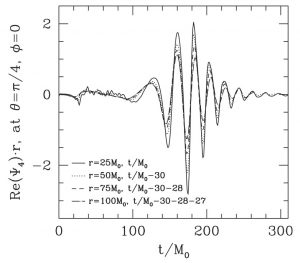5.6 Astronomy as a Case Study in the Development of Conceptual Coherence
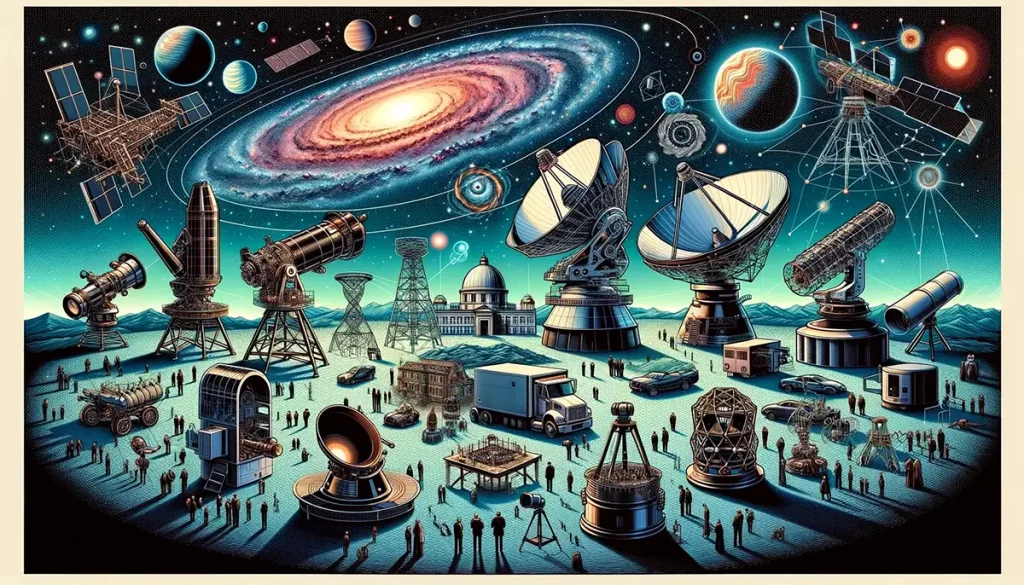
For me, intellectual progress in science need not be about finding truths but is instead concerned with the elaboration of coherent and predictively fruitful ideas. In the first instance, we do not need to be overly concerned about whether or not such ideas are absolutely and comprehensively true. In the longer term, we would hope our ideas would survive tests of falsification and pass test of verification, particularly the latter.
The activities of scientists, their observations and their theorising that give rise to an ever more elaborate network of ideas is the basis of scientific progress. My view is that we can also view intellectual progress more generally as the elaboration of coherent ideas. Whether or not these ideas happen to be true in some idealised sense is less important than their explanatory power and predictive value, since there is nothing so satisfying as a good testable story that has a pragmatic appeal. The observations made by scientists (and the rest of us) are, for the most part, not the pure ‘logically atomic facts‘ Bertrand Russell was fond of (although from a linguistic perspective we can be quite sure about the existence ‘atomic sentences‘). Instead, we make observations, which are in themselves interpretive. The theoretical explanations of science are rationalised justifications based on ‘theory-laden‘ observation.
Why Astronomy?
As an example of, how beliefs are justified by practice, observation and explanation in science, I will now consider how astronomy has progressed from ancient times to the present. This is partly motivated by the fairly recent detection of ‘invisible’ gravity waves that were found about 100 years after being first predicted and only after an enormous amount of effort. The present account is also a story of how science becomes more technologically and conceptually complex over time. In order to make sense, Astronomy like other sciences relies heavily on the coherence of ideas that form a network of interrelated and interdependent beliefs. These beliefs, as we shall see have become elaborated over time and our overall picture becomes more coherent.
By beginning with ancient astronomy and moving forward to recent times, we will also see how the complexity of observation and justification of beliefs has also expanded over time and of necessity has become logically more complex. Webs of interlinked coherent ideas have formed during the history of the subject since its inception a very long time ago. I also feel that ancient astronomers deserve our respect because some of them reached such insightful conclusions with very little technological assistance. There were, of course, many conceptual aberrations along the way. Our problem today is knowing which of our current scientific beliefs are also aberrant. As you read on, ask yourself how many scientific ideas referred to below will be regarded as valid long into the future? The short answer is some will be maintained and others will be inaccurate or incomplete. [ Note: the rest of this article is hopefully written in a way that anyone who has studied science throughout high school will understand.]
Ancient Astronomy
Science comes in many forms. Some areas of scientific enquiry are based on experiment and observation. Other types of science rely only on observation since experiments are not possible in particular circumstances. We cannot, for example, do experiments on stars. We can merely observe them. Astronomy is probably the most ancient of the observational sciences and has a very long and interesting history, involving many different cultures over thousands of years. It began with people just looking at the sky in a systematic way.
Early observers were able to distinguish the annual variations in the way the sun appeared in the sky and the different phases of the lunar cycles. They were able to distinguish between the ‘fixed’ stars and others that ‘wandered’. The ‘wandering stars’ were later described as the planets Mercury, Venus, Mars, Saturn, and Jupiter, which are all visible to the naked eye. One of the essential features of the ancient Babylonian and later Greek astronomy is that repeated observations were made and recorded. By acting in this way, the ancient astronomers were moving beyond haphazard sightings, which allowed them to record periodically occurring phenomena. More than 3,000 years ago the Shang people of China made the first known record of a solar eclipse and the appearance of a comet by carving on to so-called Oracle Bones.
Without a methodical and systematic approach to observation, there is simply less to explain, and less of what is observed can be explained. Of course, systematicity also conveys the advantage that when something unusual occurs, such as the appearance of a comet, it will become more obvious given a certain level of background familiarity or knowledge.
In ancient Greece, it was realised by some that the earth rotated around the sun (however erroneous ideas took hold instead.) The diameter of the earth was accurately estimated by Eratosthenes of Cyrene who also calculated the tilt of the earth’s rotational axis more than 2,000 years ago. Babylonian astronomers discovered the 18-year cycle of lunar eclipses. In Tehran, in the 10th century, the tilt of the earth’s axis was also accurately calculated. All this happened long before the invention of the first astronomical telescope. In other words, complex reasoning has been used for a very long time to interpret systematic observations that were made in a very simple way.
Extremely old, but nevertheless insightful explanations were developed to conceptualise those early observations. Observation and measurement then gave rise to some of the very earliest predictions in science including the motion of the planets. The combination of systematic observation, explanation and prediction led to the observational sciences as we know them today.
When observations became systematic and measured, this gave rise to practical applications. One very notable early achievement in the systematisation of astronomical knowledge was the development of the almost correct 365-day calendar in ancient Egypt, which we all take completely for granted today.
The observations of early astronomy were also used to justify spurious social ideas about the influence of very distant celestial entities, such as stars, on human affairs. These ideas developed into a body of pseudo-knowledge known as astrology. Despite ancient objections to such nonsense, this folly continued well into the 17th century. There are many reasons for this long aberration of thought, the most obvious being that humans have a desire to predict what are very often unpredictable future events. Of course, if we take the trouble to make predictions arising from explanations, we then need to be diligent and examine whether or not a series of predictions prove to be accurate. For example, we might want to compare a probabilistic forecast, made with powerful computers and sophisticated software, with the naive prediction that the weather will be same tomorrow as it is today. The next most obvious problem with astrology is that explanatory ideas need some direct relevance to the phenomena we observe. In science, the difficulty in formulating explanations is reduced by using inductive inference and by postulating mechanistic explanations, which ultimately are reduced to deductive mathematical explanations.
Scientific Instruments
One of the earliest scientific instruments, the astrolabe (a device for measuring the angular inclination of celestial bodies), was invented more than 2,00 years ago and then developed in many ways. (If you do not know how one works you can watch a short video by a youngster teaching us how to use it.) This instrument helped to produce some of the earliest ‘scientific’ or reproducible measurements and was also used as a clock. Even more remarkable was the invention of the Antikythera Mechanism, which has been recently described as “a lost history of brilliant engineering, a conception of pure genius, one of the great wonders of the ancient world”, although it did not work very well.
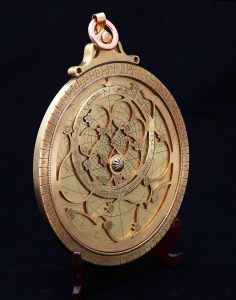
Modern Iranian Astrolabe Image
Source: Wikimedia by Jacopo Koushan (User: Jacopo188) Photograph by Masoud Safarniya (User: M.safarniya) – Own work, CC BY-SA 3.0, https://commons.wikimedia.org/w/index.php?curid=26080692
The Rise of Modern Astronomy
With the rise of technology in recent times there has been an ever increasingly complex web of interrelated stories that tell about the universe around us. Optical telescopes, first developed in the early 17th century, demonstrated the existence of more planets, moons around planets and craters on the moon. Copernicus (see also), Galileo (see also), Kepler( see also), and Newton (see also) played their parts in making astronomical observations, constructing telescopes and eventually, after thousands of years of observation, explaining the approximately elliptical orbits of the planets around the sun. However, it was not until the invention of accurate and reliable mechanical clocks that the complexities of the earth’s orbit began to be apparent. The coherent progress of science often relies on the synthesis or combinations of technologies, meaning that the inspirations are multitudinous and diverse.
Astronomical photography in the 19th century onward made very precise measurements and calculations possible. (Ironically, although perhaps not unsurprisingly, the observers were men and the ‘computers’ were hard-working women, not machines.) In addition, long-duration photographic exposures of film and more recently on solid-state sensors made it possible to see structures that were too dim for the human eye to detect.
The movement of the Sun and earth in relation to the centre of our home galaxy, the Milky Way, was of course not possible until the concepts of a galaxy and movement of stars around the core were developed. The unifying explanation for both of these types of motion is that there is a force of gravity. In this example, we can see how the developing discipline of physics became a very central part of explaining astronomical observations.
Going Beyond the Senses
Scientific instruments and processes, increase the range of observational possibilities but at the same time make explanatory ideas more indirect and thus part of an even wider web of explanation. Through the use of instrumentation things that were once ‘unobservable’ or even ‘invisible’ become detectable. We no longer rely only on our senses. Instead, we interpret more indirect observations such as the movement of a pointer on a dial or, since the advent of modern electronics, the numbers created by the digitisation of a signal received by a detector. Every observation then requires interpretation to make in any sense. There are no longer any observable ‘facts’ except the output of our detectors. The reason for this is that we need additional justifications for accepting that more indirect forms of observation validly support particular interpretations. For example, in astronomy, there was even a historical need to believe that telescopes would not distort observation of celestial bodies or that the new observations were not wrongly interpreted. Telescopic observations were for example used to justify the now amusing claims that there were canals on Mars constructed by intelligent beings. Reasons were even concocted to explain why they could not be demonstrated by astrophotography.
Astronomical spectrometers have been used since the 19th century to analyse light and demonstrate the existence of hydrogen and helium in our sun. The use of this instrument gave rise to extra-terrestrial chemistry. In fact, the evidence for the existence of Helium, thought to be the second most abundant atom in the universe, was found in space before its discovery on earth.
Radio telescopes and space telescopes operating at a range of wavelengths, not visible to the naked eye, further expanded the observational possibilities. These technologies revealed stars of many kinds (e.g. neutron stars, pulsars white dwarfs, red giants) and exploded stars called supernovae. In the 20 century, it was eventually realised that our sun and planetary system is a tiny part of the Milky Way galaxy. The observation of other galaxies and clusters and super-clusters of galaxies followed and so enormously expanded our view of the universe. More recently indirect evidence has become available concerning the existence of exoplanets on distant stars within our galaxy.


The upper image shows distant galaxies each containing billions of stars observed by the Hubble Space Telescope. In 1914 Vesto Slipher found the first evidence that galaxies rotate around their centre of mass.
The video explains the position of our home galaxy and the local cluster of galaxies within the Laniakea Supercluster. It also shows that the galaxies in our local region of the universe are being pulled towards the ‘great attractor‘. The structure of the universe now seems very dynamic.
Changes to light
Astronomy and Astrophysics have now developed to a level where their complicated explanations have exceedingly complex justifications based on many inter-related ideas. A few examples now follow. In 1912 Vesto Slipher used astronomical spectroscopy to discover that light from far-off galaxies is ‘red-shifted‘. The idea, simply put, is that light of all wavelengths becomes slightly redder as it travels the universe towards us.
The simplest and most intuitive explanation of this isolated observation might have been that the photons ‘age’ in some way. Over the course of billions of years, as they travel at high speed through the universe towards earth, the photons of light might have been imagined to change by losing energy. However, science does not consider observations in isolation. There are theoretical reasons, which have emerged in the related discipline of physics, for not using this explanation. Explanations in science need to work together to present a comprehensive picture in a way that epistemologists refer to as coherent. In this example, our fundamental physics and our astronomy need to work together.
A much more radical explanation of the red-shift observations was developed, in which the entire universe is expanding. It is now believed that the photons of light appear different to us when they arrive here on earth because the ’empty’ space-time through which the photons have travelled has expanded. The periodic oscillations of the particles or quanta of light have become temporally stretched. The further the distance they have travelled the more expansion of space they will have ‘encountered’ and the redder they will have become. Thus light arriving here from far away galaxies will be redder than that coming from much closer sources. This explanation is referred to as cosmic expansion and is one of the most radical ideas ever proposed in the history of human culture for it implies that the whole of the observable universe is changing in a very fundamental way.
Clearly, science does do not always operate on the Principle of Parsimony used in problem-solving, which instructs us to chose the simplest explanation that fits of all of our observations. This complication of scientific explanation arises from the fact there is a need to integrate a complex web of ideas, not just isolated observations.
Ancient radiation from the background of space
Another equally impressive claim arose from the accidental discovery of the cosmic microwave background radiation that we can observe in the sky in every direction with a directionally sensitive ariel. This finding supports the idea of the ‘Big Bang‘ origin of everything we can see. The explanation of the background radiation is that after the Big Bang the expanding universe was extremely hot and as a result filled was filled with radiation, which reflected that temperature. As the background space of the universe and its constituents cooled to its present temperature of 2.725 degrees centigrade above absolute zero, the frequency distribution of the ‘black body radiation‘ became characteristic of an extremely cold object that has peak ‘power’ in the microwave frequencies.
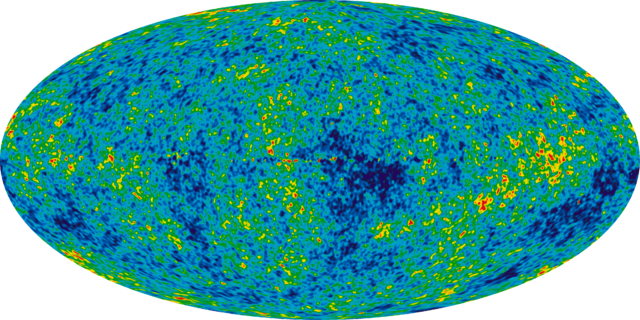
The Cosmic Microwave Background temperature fluctuations from the 7-year Wilkinson Microwave Anisotropy Probe data seen over the full sky. The average temperature is 2.725 Kelvin degrees above absolute zero (absolute zero is equivalent to -273.15 ºC ), and the colors represent the tiny temperature fluctuations. Red regions are warmer and blue regions are colder by about 0.0002 degrees. This map is the ILC (Internal Linear Combination) map, which attempts to subtract out noise from the galaxy and other sources. The technique is of uncertain reliability, especially on smaller scales [1], so other maps are typically used for detailed scientific analysis
From a philosophical perspective, it is very noteworthy that the prediction of this radiation was made in 1948 but only discovered at the Bell Telephone Laboratories in 1965. It is a hallmark of good scientific explanations that they facilitate testable predictions. However, we also need to bear in mind that once efforts have been made to test predictions, either by experiment or by enhanced observation, any new finding will be examined, at least initially, using the same explanatory theories that were used to make those initial predictions. It is usually only when such predictions are inconsistent with new data that we will even see the need for more refined explanations. There is a form of a conceptual horizon that we often struggle to see beyond.
The Social Perspective
If we examine the practice of science from a social perspective, we could argue that professional astronomers, astrophysicists and or cosmologists of today who want to make a contribution to their fields of research are obliged to believe in the existence of gravitational fields, the usefulness of Albert Einstein’s theory of general relativity, gravitational lensing of light, the existence of ‘black holes‘ formed by the collapse and fusion of very old stars, and the existence of the Big Bang. Going beyond that, there has to be an additional theory of how the present structure of the universe was formed since that is not explained by the ‘Big Bang’.These are just a few examples of the required beliefs needed to be part of the professional astronomical community. If you doubt this, ask yourself how many grant-holding astronomers are there who actively deny such beliefs.
There is, in my opinion, more profound (epistemic) reasons why scientists would choose to adhere to such ideas rather than just being part of a compliant majority, although that also plays a part in scientific development. One reason is that current ideas are the most consistent and logically coherent that have so far been developed. Another reason is that current data is well described by the present theoretical explanations. Perhaps more importantly, from a philosophical perspective, current theories have been used to predict future observations. Indeed, incredible predictions have been made and observationally tested in astronomy. One of the more abstract and surprising predictions is the existence of completely invisible waves of gravitational field change that travel at the speed of light through the universe. This prediction involves the remarkable belief that ’empty’ space can be distorted by gravity.
Predicting Gravitational Waves
Using his ideas about gravitation, Einstein predicted the existence of gravitational waves in 1916. Looked at very simply we can say that if an object has mass it creates a gravitational field around itself. Einstein used his theory of general relativity to provide a geometric description of the gravitational field using the mathematics of differential geometry, which is used to describe curved surfaces. We humans literally feel this field as a force that holds us to the surface of the Earth or makes us fall from trees. The curvature of the space-time field also keeps satellites in orbit. Of course merely providing a geometric description of the gravitation, ingenious though that was, is not yet a complete enough explanation for the theoretical physicists of today who seek a more fundamental explanation concerned with the nature of space and matter.
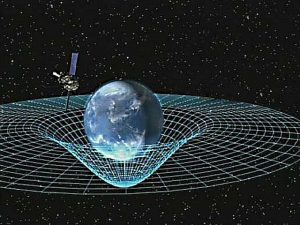
Satellites are kept in orbit by the distortions of the space-time field created by the mass of the earth. Image source: NASA https://www.nasa.gov/mission_pages/gpb/gpb_012.html
As we travel away from the earth into space we become aware that the gravitational field of the earth exerts less force on us i.e. the ‘strength’ or curvature of the locally induced field declines. When the earth moves a dynamic disturbance of 4-dimensional space-time must be created by that movement. That disturbance must propagate through space at the speed of light if general relativity is correct.
If a very massive object, or a pair of objects, was to move relative to the earth, the disturbance of the object’s gravitational field as sensed on earth would also vary over time. If this idea is correct we could be subject to very small effects from extremely massive distant objects as they move or spin in space, even although they might be very far away.
If a pair of extremely massive objects moved around one another in ever decreasing orbits, they would be eventually expected to fuse to form more massive single object. As the energy of rotation and spin (called angular momentum) is lost it would be expected to produce waves that distort space-time. Without the conceptual framework of general relativity, the idea does not seem to make any sense. Scientific ideas, as we can see from this example, to even be intelligible need to hold together. By this, I mean that we cannot hold individual concepts without regard to their place within a wider framework of related ideas.
The First Observational Evidence for Black Holes
In 1974, two American physicists discovered a rapidly pulsating source of energy using the giant Arecibo Radio Telescope in Puerto Rico. After very careful analysis of the signal, they concluded that radio waves were being emitted by a neutron star that was orbiting in less than 8 hours around a common centre of gravity with another neutron star that was not directly detectable. Notice in the last statement we are asked to believe in the existence of something we cannot ‘see’ even indirectly. Although there was only one set of observations, a creative leap of imagination was required to produce a rationalised explanation. In this case, like so many others, a mechanistic deductive logic is being employed to postulate the existence of an invisible entity.
This proposed pair of neutron stars form what is now called the Hulse-Taylor binary system after its discoverers. Very precise analysis of the deduced orbits showed that there was an extremely small shortening of the orbital period by 75 millionths of a second per year, as the stars slowly come closer to each other. Even although this orbital change is extremely small by everyday considerations, it can be precisely accounted for by Einstein’s theory of General Relativity to within an accuracy of 0.5%. Because of the agreement of observation and theory was so good, Russell Alan Hulse and Joseph Hooton Taylor, Jr were able to infer indirectly that gravitational wave energy must be radiating from the binary star system. As a result, these physicists were awarded the Nobel Prize for Physics in 1993. As we can see the agreement of observations and theory is highly prized in science. Nevertheless, there is a dogma that the basic data always trumps theoretical explanation. In other words, although the data may be invariant the explanation might change.

An artistic impression of the Hulse-Talyor Binary Star System Image source: http://www.nobelprize.org/nobel_prizes/physics/laureates/1993/press.html Copyright © Nobel Media AB 2017
Prediction of Gravitational Waves
After much technological and scientific development over the 90 years from the publication of Einstein’s theory, it was predicted that another more direct form of evidence for gravitational waves could be found. Theoretical physicists predicted that gravitational waves might be observed following cataclysmic events such as the fusion of collapsed stars (black holes). Please bear in mind that until 2019 no scientist had ever indirectly observed a black hole, in the sense of ‘seeing’ the shadow of one in an image.
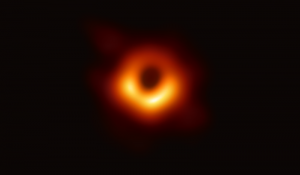
Theoretical prediction of the pattern of gravitational waves emitted during the merger of 2 black holes. Image Source: Evolution of Binary Black-Hole Spacetimes by Frans Pretorius, Physical Review Letters 95, 121101 (2005)
If the predictions were correct, we feeble humans might then be able to detect that space itself would be distorted as these gravitational waves pass through the minuscule volume that we occupy here on planet earth. This signal would be expected to have the form of a very brief packet of oscillations or waves in the pattern shown in the diagram above. What we might normally think of as ’empty’ space would be distorted. (These distortions of space would be very loosely analogous to a metal bar transmitting a compression wave after being struck by a hammer. )
Apparently empty space itself would transmit or propagate those distortions at the speed of light. How utterly mind-bending is that? In classical terms, we are implying that what we would normally believe to be empty space or nothingness actually has some form of stiffness or elasticity.
Of course, at the very limits of modern theoretical physics, the theoreticians are now considering the possibility that there is an almost unbelievably fine interlinked granular structure to space, which can somehow transmit the predicted distortions. (As yet there is no way to even consider an experimental test that would detect a fine structure of space.)
Science as Metaphysics Not Fact
Please note that no physicist sat down with a metaphysical philosopher and sought their permission to make such apparently outlandish predictions. It is the philosophers who must learn about the ways to conceive of existence from the brilliant theoretical physicists (and other scientists) who originate such ideas.
Science, in a widely conceived sense, has become the new metaphysics for it seeks to explain the existence of everything, including the void, and its apparent properties. Of course, this places a tremendous conceptual burden on philosophers who seek inspiration from science. Mark Titus expands on this view in his thought-provoking essay Science As Philosophy. (You can also read a whole book-length attack on analytical metaphysics by James Ladyman and colleagues entitled ‘Every Thing Must Go: Metaphysics Naturalized‘. However, as these authors seem to feel that “enlightened” thinkers should be striving for “objective truth” this might not be a good use of your money and time, depending on your point of view.)
The recently acquired evidence for the existence of gravitational waves has been presented to the public as a fact in various news outlets. What ideas and activities are these apparent ‘facts’ based on? How can it be that scientists can claim to detect evidence for invisible waves? Where would the waves come from? What is it that the scientists have actually predicted in advance? How important is the theory in interpreting the data? What apparatus did they construct to make observations? What does the data actually look like?
Constructing the Observational Apparatus for Gravitational Wave (GW) Detection
It would seem that holding these very sophisticated beliefs referred to above was all that was needed to justify the construction of enormously expensive devices to detect gravitational waves. This is a fine exemplar of what I have already referred to as faith.
The very first attempts to construct apparatus to detect gravitational waves were based on minute changes that might occur within large aluminium cylinders. In 1968 a claim was made, using this apparatus, that gravitational waves might have finally been detected. The story of this claim even appeared in a popular magazine that you can read for yourself. However, when other scientists tried to repeat the findings by building and operating similar detectors. They could only detect what they interpreted as ‘random noise’. They reached this conclusion by, what were claimed to be, more rigorous methods of analysis. In this episode of the story, we see how a social consensus is required, albeit one that emerges from rational considerations. In principle, this situation is not so different from how a jury might ideally operate in a court case.
Initial Failure was not a Philosophical Problem
After many developments in physics, electronics, computing and engineering, it was believed the construction of a much larger and more sensitive apparatus based on the use of laser beams and mirrors might produce the long-awaited ‘evidence’. Very large detectors were constructed in the U.S.A called LIGO and operated for a considerable period. A UK-German collaboration, the Geo600, also operated for many years. However, no signal was detected either in Europe or the U.S.A.
Notice that in the absence of evidence there is a strong dilemma that scientists have to face. Are the theories wrong or are the investigative and analytical procedures not sophisticated enough? We have a much more difficult situation than the Duhem-Quine hypothesis of underdetermination of theory might suggest. ( I will return to this topic in another essay.)
Eventually, the instruments were made more sensitive and acquired the new title Advanced LIGO. Another larger instrument, VIRGO, was built in Italy as a part of a European cooperation. During this very long period of development, testing and operation, the scientists were motivated by what is generally regarded as a good theory of gravity. A negative result was simply not acceptable to them! The scientists were very optimistic for another very simple reason. A tenfold increase in sensitivity of the apparatus would increase the volume of the sphere in which events could be detected by 1000 times since the volume of a sphere is related to the cube of the radius. (Of course, it was around 225 BC that Archimedes laid the groundwork for this realisation when he examined the relationship of the volume of cylinders to that of spheres.)
Since the initial observation periods the detector network was expanded again when an underground Japanese GW detector became operational in 2020.
Mirrors and Laser Beams
So how does the latest generation of enhanced detectors work? It was believed that if the space between two 40 kg mirrors separated by 4 kilometres was subjected to a gravitational wave the distance between those mirrors would very transiently expand and shrink by an incredibly small amount, even by scientific standards. Detectors were built, where it was hoped that tiny distortions of space could be measured (less than a ratio of 0.000 000 000 000 000 000 001 or 10–21). The implied distance is much less than the size of a proton!
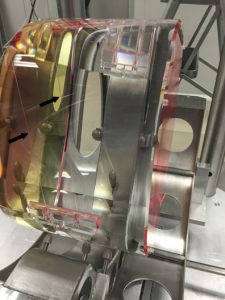
40 Kg Mirror in the European VIRGO Detector Notice the 2 glass suspension fibres (arrowed), which is just the last part of a very complex stabilisation system, explained in the animation below. Image Source VIRGO Collaboration http://public.virgo-gw.eu/index.php?gmedia=zK53B&t=g
The mirrors had to be physically isolated from their surroundings by being hung on fine glass filaments with additional mechanical devices used to isolate them from vibration (shown in the animation below). The physical isolation had to be so good that local disturbances did not transmit background vibrations within the frequency range of interest that were greater than the signal strength. Just to be sure that environmental disturbances were not producing any false signals, the research team used ”an array of sensors: seismometers, accelerometers, microphones, magnetometers, radio receivers, weather sensors, ac-power line monitors, and a cosmic-ray detector”

Diagram of the apparatus used to detect gravitational waves. What I am calling mirrors the scientists refer to as ‘test masses’. Image Source: Observation of Gravitational Waves from a Binary Black Hole Merger B. P. Abbott et al. (LIGO Scientific Collaboration and Virgo Collaboration) Physical Review Letters, 116, 061102 (11 February 2016)
The whole apparatus, including the detectors, is contained within an ultra-high vacuum so that even the air does not disturb the system. A high power laser beam is split and shone at both sets of partially reflecting and transmitting mirrors in each detector arm. When the beams were reflected back and forward between the mirrors effectively for 280 times the light path becomes equivalent to 1120 km in length within each detector arm. The light emerging from the optical cavities is amplified with a power-boosting mirror to very high light power in each detector arm. (Standing waves of certain resonant frequencies are formed in the cavities and these effectively amplify the laser power.) As the combined laser beams emerge towards the sensor, the light pattern is further enhanced by ‘signal recycling’ mirrors.
Enhanced interference patterns are then generated when the recombined beams from each arm of the apparatus arrive on the sensor. If the distance between the mirrors changes very very slightly during the passage of a gravitational wave the phase of the emerging beams should become slightly shifted so generating a change in the interference pattern that would vary very rapidly over time. If that variation over time is similar enough to that predicted by theory (illustrated above), then the scientists would claim to have indirect evidence of gravitational waves passing by, for a small fraction of a second.
A gravitational wave would be expected to shorten the distance between the masses in one arm of the detector and lengthen the distance in the other during one half of a wave cycle. The opposite would then be expected to happen in the other half of the cycle. Changes will only be detected if the direction and polarisation of the gravitational wave are oriented appropriately with respect to the plane of the detector. So not every wave passing through the system can be detected even in principle.

The length of the beams between the mirrors on each arm of the detector is 4 kilometres shown here at the LIGO Hanford Observatory. Two mirrors hang within each arm of the detector. The detection system operates within a tube under high vacuum conditions. Image source: LIGO
Of course, more than one detector, such as that shown above, would be required and the distance separating them would need to be large enough so that the signal should arrive at a measurably minute fraction of a second apart even though light travels at roughly 300,000,000 metres per second.
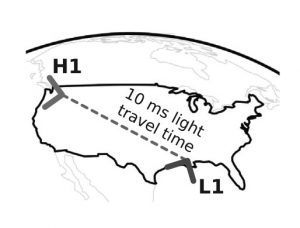
Image Source: Observation of Gravitational Waves from a Binary Black Hole Merger B. P. Abbott et al.* (LIGO Scientific Collaboration and Virgo Collaboration) Physical Review Letters, 116, 061102 (11 February 2016)
For this reason, 2 detectors were used, one in Hanford in Washington State and the other in Livingston, Louisiana, separated by a distance of 3002 km. Notice that the detectors have different orientations, as shown by the grey brackets. Of course, incredibly accurate clocks were required to compare the arrival of the signals at these 2 widely separated locations. GPS receivers were used to measure the timing of the signals to within 10 microseconds.
The Experimental Evidence
So what might the published evidence of gravitational waves look like when presented to the community of scientists, bearing in mind they were possibly not going to see the raw data. Look at the image below and then reflect on the fact that this evidence is part of the justification of an enormously complex set of interrelated beliefs. This evidence is just the latest part of the justification for the very remarkable claim that ’empty space’ can be dynamically distorted by propagated variations in a gravitational field.
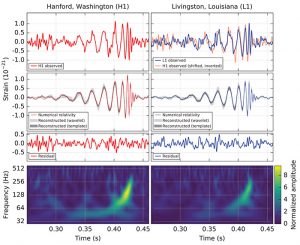
Image Source: Observation of Gravitational Waves from a Binary Black Hole Merger B. P. Abbott et al.* (LIGO Scientific Collaboration and Virgo Collaboration) Physical Review Letters, 116, 061102 (11 February 2016)
The evidence for the first gravitational wave detection is shown in the upper row above. Those squiggly lines record the fact that the mirrors changed in distance from each other by an almost infinitesimally small distance in which the length ratio change was of less than 10 -21, or to use the vocabulary in the graph, ‘space’ had been strained (compressed and stretched). Notice that the detection is not completely identical at the two sites. It is also worth noting that the scientists combed the data from a 16 day period in an automated way using theoretical predictions to search for the kind of event shown in the 0.45 of a second above. In other words, a theory was even used to select the data. Of course, the recorded signal was not identical to the smooth predictions of the theory since all sorts of random events (shown in the lower residual graphs) complicate what is detected in practice. Generation of the smoothed graphs in the middle row and the ‘residuals’ in the bottom row by data processing also involved a bit of very educated Bayesian statistical guesswork.

Image Source: Observation of Gravitational Waves from a Binary Black Hole Merger B. P. Abbott et al.* (LIGO Scientific Collaboration and Virgo Collaboration) Physical Review Letters, 116, 061102 (11 February 2016)
The diagrammatic sequence below shows an idealised interpretation of the experimental data. Bear in mind no one can ever directly observe the objects shown in the lower diagram. However, the authors claim that this is direct observation of black holes. Nevertheless, the scientists involved have then gone on to calculate what size of objects could produce this signal, how much they were spinning and how far away they are from Earth (not discussed here).
Warped Space and Time Around Colliding Black Holes (Courtesy Caltech-MIT-LIGO Laboratory) Remember that these enormous masses are moving at an incredible speed so that the events described in the animation occur in less than a second in real time. Look at the waveform graphs as the animation proceeds. The blue labelling, which begins after a few seconds of the video, marks the relevant point in the animation. Animation created by SXS, the Simulating eXtreme Spacetimes (SXS) project (http://www.black-holes.org)
If these waves have been created for a very long time in the history of the universe, as is now thought to be the case, there should be a Stochastic Gravitational Wave Background (SGWB) produced by “incoherent superposition of GWs emitted by many sources”. In other words we just might be immersed in a universe that is subject to random ultra-minute distortions of space-time. Such phenomena that world have made absolutely no sense to the astronomers of Ancient Babylon.
Repetition
Although the first ‘event’ described above and the explanations that it generated were an extremely important milestone in the history of science they were just the beginning in a new area of observational research. Since the first event known as GW150914, others of different magnitudes have been recorded. They have the labels like GW151216, LVT121012 and GW170104 (where the nomenclature is based on the calendar date of detection). It is only with repetition of the observations that the richness and diversity of events can be systematically catalogued. Of course, each individual event is taken as adding to the existing body of knowledge as well as supporting the underlying theory. (Now an increasingly long list of detections is published). This is a triumph of the inductive and deductive methods of reasoning on which science is based.
Uncertainty Still Remains
In the case of the early event labelled LVT121012 it is noteworthy that the authors of the scientific paper were not themselves completely convinced that they have observed gravitational waves for they state that there the signal detected had “an 87% probability of being of astrophysical origin”. The other events that the scientists are much more confident about explaining are still not absolute claims but have a very high degree of certainty calculated at 99.9999% (or described in statistical terms as 5 Sigma, of 5 standard deviations). In the increasing list of detections, various probabilities of detection are now specified.
If waves have been created for a very long time in the history of the universe is now thought that there should be a Stochastic Gravitational Wave Background (SGWB) produced by incoherent superposition of GWs emitted by many sources”. In other words we just might be immersed in a universe that is subject to random ultra-minute distortions of space-time, a phenomenon that world have made absolute no sense to the astronomers of Ancient Babylon.
In rigorous mathematically-based sciences, justification can on occasions be expressed as a ‘degree of certainty’ but not as an absolute belief. Indeed in some contexts, absolute truth does not even seem a legitimate goal of research. The production of pragmatically ‘useful’ or enlightening ideas is more important.
What does Gravitational Wave Detection Tell Us About Science
Some might say it is a ‘fact’ that humans have now observed gravitational waves. I would argue instead that we are provisionally justified in reaching this explanatory conclusion. There is little point in saying as some commentators, such as Richard Dawkins, have that scientific ideas are provisionally true when we just mean it is provisionally accepted until a better explanation might come along.
The early conclusions of gravitational wave research are based on a very complex series of interlinked theories and a stupendous amount of human activity (just look at the enormous author list on the first scientific paper consisting of people from 68 institutions).
If we had no theoretical justification to interpret the graphs above in a certain way they would just be a bunch of almost meaningless squiggles. More informed observers would perhaps say the surface of the mirrors were moving by a tiny amount or there was some local vibration. The observation that the same thing happened almost at the same time in 2 widely separated sites would be intriguing. It is only because the speed of light has been measured, and because of the theory of general relativity and sophisticated numerical predictions, that we might infer the detection of gravitational waves.
Of course, you might legitimately ask yourself is there any other cause for this minute signal? We need to accept that we are fallible and our interpretations might be wrong in science (as in other domains of human enquiry or assertion). So the answer could be that another explanation might be proposed in future however for the moment this is the most logically coherent explanation that we have.
It is evident from these considerations, and the experimental descriptions above that science can be very complex both at a practical and theoretical level. Practical activity and conceptual synthesis are both required to produce justifications of belief. Abstract theorising is not enough in itself to produce intellectual progress.
In addition, we can see that there is a very intricate web or network of interrelated beliefs that support particular justifications. Even the act of observation can require a very considerable theoretical interpretation. Making observations when testing general theories in science is not simply recording ‘facts’. Indeed, it seems fair to conclude that in some situations there are few if any observation-based ‘facts’, since every step in an investigatory process might be interpretative.
Apparent progress in science relies on interpreted observations that are theory-dependent. However, we feel more reassured when theories can lead to predictions and these predictions can also be tested. Some scientists argue that if a theory cannot be used to make a hypothetically testable prediction, we should not label it ‘scientific’. I will return to the subject of prediction.
Acknowledgement
This short essay was initially inspired by an excellent public lecture at Glasgow Skeptics given by two gravitational wave researchers, Angus Bell and Margot Phelps, from the University of Glasgow and was updated after their colleagues discussed later findings at the Glasgow Science Festival in 2017. Further changes were made in 2018-22.
Version 2.4.6
Further Reading
What is this thing called Science? Allan Chalmers http://www.mheducation.co.uk/9780335262786-emea-what-is-this-thing-called-science (An easy to read and well-respected introduction to the philosophy of science, now in its 4th revised edition. The author was an experimental physicist and so has a good understanding of how science works)
Behold: science as seeing by Gene Tracy (2018)
https://aeon.co/essays/seeing-is-not-simple-you-need-to-be-both-knowing-and-naive
Evolution of Binary Black-Hole Spacetimes by Frans Pretorius Physical Review Letters 95, 121101 (2005)
Observation of Gravitational Waves from a Binary Black Hole Merger B. P. Abbott et al. (LIGO Scientific Collaboration and Virgo Collaboration) Physical Review Letters, 116, 061102 (11 February 2016) http://physics.aps.org/featured-article-pdf/10.1103/PhysRevLett.116.061102 ( An important paper in the history of physics describing the first gravitational wave detection by interferometry)
A Brief History of Gravitational Waves JL Cervantes-Cota, Galindo-Uribarri and GF Smoot https://arxiv.org/ftp/arxiv/papers/1609/1609.09400.pdf ( A very interesting and beautifully written and illustrated historical account of the science, which also describes Einstein’s wavering on the subject of gravitational waves)
Gravitational Waves, Wikipedia https://en.wikipedia.org/wiki/Gravitational_wave
Gravitational waves will bring the extreme universe into view by Daniel Hoak https://aeon.co/ideas/gravitational-waves-will-bring-the-extreme-universe-into-view (A beautifully written and illustrated short article for lay people appearing in the free online Aeon Magazine.)
More Explanatory Videos
Steve Campbell
Glasgow, Scotland
2017-2022
< previous | Index | next available section >
